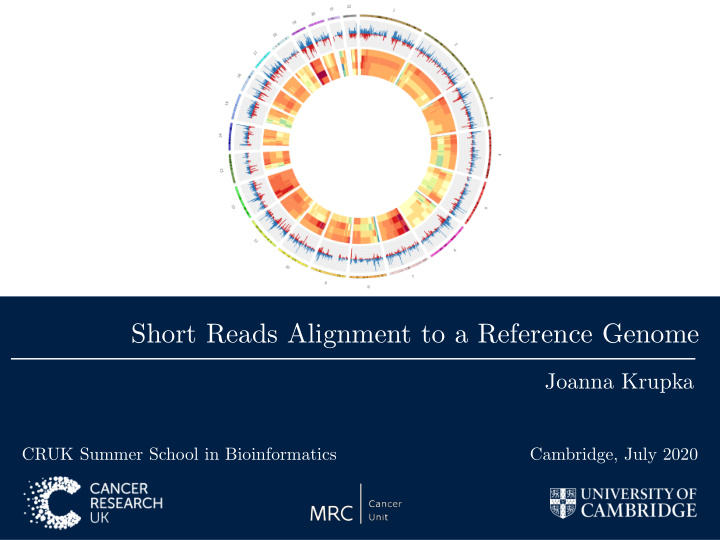



Short Reads Alignment to a Reference Genome Joanna Krupka CRUK Summer School in Bioinformatics Cambridge, July 2020
Shotgun Sequencing and sequence assembly approaches Commins J. et al, Biol Proced Online 11(1) 2015 Mapping to reference sequence De Novo assembly Recreate the genome with using prior Recreate the genome with no prior knowledge knowledge as reference Problem with repeated regions, high coverage and long Mapping is as good as reference used reads required 2
Mappability Rozowsky J. Et al. Nat Biotechnol 2009 Mappability (or uniqueness) is a measure of the ability of aligning the short reads to a unique location in the reference genome. Mapping uncertainty if the reads are shorter than a repeat region ? Repeat-regions 3
Short sequence mapping tools More than 80 di ff erent mappers https://www.ecseq.com/support/ngs/what-is-the-best-ngs-alignment-software 4
Short sequence mapping tools eg. Whole Genome Sequencing eg. RNA-Seq exon exon exon exon intron intron Not splice aware Splice aware Bowtie2 STAR BWA TopHat2 Hisat2 Reference genome Annotations with exons genomic with exons genomic coordinates coordinates Alternatively: Reference transcriptome 5
Short sequence mapping tools eg. Whole Genome Sequencing, ChIP-Seq eg. RNA-Seq exon exon exon exon intron intron Not splice aware Splice aware Bowtie2 STAR BWA TopHat2 Hisat2 Reference genome Annotations with exons genomic with exons genomic coordinates coordinates Alternatively: Reference transcriptome 6
ENCODE: encyclopedia of DNA elements https://www.encodeproject.org The goal of ENCODE is to build a comprehensive parts list of functional elements in the human genome employing variety of assays and techniques. 7
Annotations: GTF/GFF file Resources: GENCODE annotation is made by merging the manual gene annotation produced by the Ensembl-Havana team and the Ensembl-genebuild automated gene annotation. RefSeq exon exon intron Gencode vs. Ensembl - The gene annotation is the same in both files. The only exception is that the genes which are common to the human chromosome X and Y PAR regions can be found twice in the GENCODE GTF, while they are shown only for chromosome X in the Ensembl file. - GENCODE GTF contains also APPRIS tags and the annotation are on the reference chromosomes only Always make sure that annotations match the genome FASTA file (the same version & source) 8
Short sequence mapping tools eg. Whole Genome Sequencing, ChIP-Seq eg. RNA-Seq exon exon exon exon intron intron Not splice aware Splice aware Bowtie2 STAR Pseudo-aligners BWA TopHat2 Hisat2 Reference genome Annotations with exons genomic with exons genomic coordinates coordinates Alternatively: Reference transcriptome 9
Annotations: GTF/GFF file Header * * * feature type {gene,transcript,exon,CDS,UTR,start_codon,stop_codon} exon Transcript/gene start_codon stop_codon 3’UTR 5’UTR CDS * New line 10
Annotations: GTF/GFF file Header * * * Genomic coordinates Annotation source Strand Additional information Gene id Gene name Exon number Transcript id Transcript type Exon id Gene type Transcript status Level Gene status Transcript status * New line 11
Pseudo-aligners - Quantification estimates rather than base-to-base alignment Salmon - Can model sequencing bias, eg. GC-bias, fragment length - Can handle multi mapping Sailfish - Faster Kallisto - Improved accuracy at the transcript level Zhang, C., Zhang, B., Lin, L. L., & Zhao, S. (2017). Evaluation and comparison of computational tools for RNA-seq isoform quantification. BMC Genomics, 18(1), 1–11. 12
Before you align checklist & standard workflow - Do I need splice-aware aligner? - Am I using right genome version? (hg38 - human, mm10 -mouse?) - Do annotations match the reference genome? - Read manual, select parameters, check default settings Standard alignment workflow Reference Genome Annotations FASTA GTF (optional) Genome index Sequenced reads Once per genome FASTQ Alignment Pseudo-alignment Transcript abundance Aligned reads BAM 13
Coverage and Depth Coverage: average number of reads exon exon intron of a given length that align to given region. Depth: redundancy of coverage or the total number of bases sequenced and aligned at a given reference position. The average depth of sequencing coverage can be defined theoretically as LN/G , where L is the read length, N is the number of reads and G is the haploid genome length. Example: If we sequence a genome with total length of 100 nucleotides and we have 500 reads, 25 nucleotides length each - the average depth of sequencing is 125 Sims, D., Sudbery, I., Ilott, N. E., Heger, A., & Ponting, C. P. (2014). Sequencing depth and coverage: Key considerations in genomic analyses. Nature Reviews Genetics, 15(2), 14
Mapping quality check SAMstat is a C program that plots nucleotide overrepresentation and other statistics in mapped and unmapped reads and helps understand the relationship between potential protocol biases and poor mapping. Log files returned by aligner, eg Log.final.out file from STAR FastQC 15
Let’s practice! 16
Recommend
More recommend